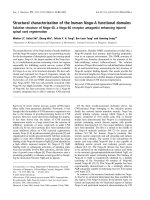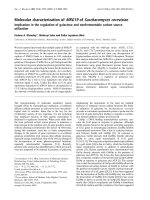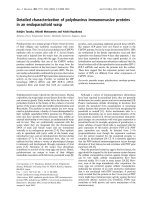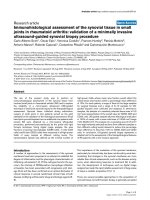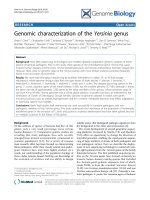Báo cáo y học: "Molecular characterization of partial-open reading frames 1a and 2 of the human astroviruses in South Korea" doc
Bạn đang xem bản rút gọn của tài liệu. Xem và tải ngay bản đầy đủ của tài liệu tại đây (505.89 KB, 5 trang )
SHOR T REPOR T Open Access
Molecular characterization of partial-open reading
frames 1a and 2 of the human astroviruses in
South Korea
Jae in Lee
1†
, Gyu-Cheol Lee
2†
, Young hee Oh
1
, Young ki Lee
3
, Min young Kim
1
, Chan Hee Lee
4*
Abstract
Human astroviruses (HAstVs) are among the major causes of gastroenteritis in South Korea. In this study, the partial
regions of the open reading frame (ORF) 1a and ORF2 genes of HAstVs from gastroenteritis patients in nine hospi-
tals were sequenced, and the molecular characterization of the viruses was revealed. 89 partial nucleotide
sequences of ORF1a and 88 partial nucleotide sequences of ORF2 were amplified from 120 stool specimens. Phylo-
genetic analysis showed that most of the nucleotide sequences of ORF1a and ORF2 were grouped with HAstV
type 1 but had evolutionary genetic distance compared with the reference sequences, such as the HAstV-1 proto-
type, Dresden strain, and Oxford strain. According to the phylogenetic analysis, some nucleotide sequences includ-
ing SE05 06041, SE0506043, and SE0506058, showed the discrepancy of the genotypes, but there was no proof of
recombination among the HAstV types. In conclusion, this study showed that the dominant HAstV isolated from
the Seoul metropolitan area in 2004-2005 was HAstV type 1, and that Korean HAstV-1 had the genetic distance in
evolution compared with the reference sequences of HAstVs. Lots of nucleotide sequences of the ORF1a and ORF2
genes of HAstV will be useful for studying for the control and prevention of HAstV gastroenteritis in South Korea.
Findings
Astroviruses (AstVs), belong to the Astroviridae family,
are non-enveloped, single-stranded, an d positive-sense
RNA viruses [1]. Their genomes have both 5’ and 3’
non-translated regions, and contain three open reading
frames (ORFs), denoted as ORF1a, ORF1b, and ORF2,
which encode a serine protease, an RNA-dependent
RNA polymerase, and a structural protein, respectively
[1,2]. AstVs are known to infect humans as well as a
variety of mammalian and avian species [3-5]. In
humans, eight serotypes have been described, which
have been associated with up to ~10% sporadic cases of
nonbacterial diarrhea in children [6-10] and 0.5-15%
outbreaks [11-13].
Walter et al. (2001) analyzed the gene of AstVs and
found that the ORF2 region belonged to human AstV
(HAstv)-5 whereas the ORF1b region belonged to
HAstV-3, and that recombination occurred between the
HAstV types [14]. Besides, in some other studies,
recombination was found to occur between mamastro-
viruses and HAstV [15]. Such recombination may result
in a new epidemic HAstV because it is similar to anti-
gen drift of influenza viruses [16-19]. Therefore, charac-
terization of HAstVs genome is important to
understand the recombination between human and
mammalian AstVs, the origin of the viruses, and their
molecular evolution, as well as the phylogenetic rela-
tionship among the HAstV genotypes. For this purpose,
there is a need to ob tain more complete genome
sequences of HAstV. The complete genome sequences
ofsevengenotypes(HAstV-1,2,3,4,5,6,and8)and
the HAstV-7 ORF2 sequence are available [18,20-23]. In
this study, the partial nucleotide sequences of ORF1a
and ORF2 of HAstVs, responsible for sporadic gastroen-
teritis in South Korea, were obtained, and their molecu-
lar characteristics were investigated.
From 2004 to 2005, stool specimens of patients sus-
pected to have acute gastroenteritis were provided by
nine hospitals located in the Seoul metropolitan area.
1 g of a stool specimen was added into 9 mL phos-
phate-buffered saline solution, and t hree or four 3-mm
* Correspondence:
† Contributed equally
4
Department of Microbiology, College of Natural Sciences, Chungbuk
National University, Cheongju, Chungbuk 361-763, Republic of Korea
Full list of author information is available at the end of the article
Lee et al. Virology Journal 2010, 7:221
/>© 2010 Lee et al; licensee BioMed Central Ltd. This is an Open Access article distributed under the t erms of the C reativ e Commons
Attribution Lice nse (http://c reativecommons.org/licenses/by/2.0), which permits unrestricted use, distribut ion, and reproduction in
any medium, provided the original work is properly cited.
glass beads were added. The mixture was vigorously
shaken via vortexing and was centrifuged at 4°C and
3000 rpm for 30 min. The 200 μLof10%stoolsuspen-
sion was used for extracting RNA via the Tri-reagent
method [24] and the extracted viral RNA was used for
RT-PCR. The Mon340 and Mon348 primers were used
for the amplification of the ORF1a region, and the
Mon269 and Mon270 primers for the amplification of
ORF2 (Table 1). For the synthesis of cDNA, 8 μL dNTP,
5 μ L 5X buffer, 2.5 μL 10 pmole Mon348 or Mon270,
0.5 μL RNase inhibito r (Promega, Madison, WI), 0.5 μL
MMLV reverse transcriptase (Promega), and 3.5 μL
diethyl pyrocarbonate (DEPC) treated water and 5 μL
RNA extract were added. The reaction conditions for
the synthesis of cDNA we re 42°C/60 min, 95°C/5 min,
and 4°C soaking. For PCR, synthesized 5 μLcDNAwas
added to 6 μLdNTP,5μL 10× PCR buffer, each of the
2.5 μL10pmoleprimers,0.5μLexTaqpolymerase
(TaKaRa, Otsu, Shiga, Japan), and 28.5 μL DEPC treated
water. The PCR conditions for ORF1a were 94°C/3 min,
94°C/30 sec, 50°C/20 sec, and 72°C/30 sec, 30 cycles, 72°
C/5 min, and for ORF2, 94°C/3 min, 94°C/30 se c, 50°C/
30 sec, and 72°C/1 min, 35 cycles, and 72°C/5 min. The
amplified gen e products were observed in 1 .2% agarose
gel. The PCR products were purified using a PCR purifi-
cation kit (SolGent Co., Daejeon, South Korea) and were
sequenced using ABI 3730XL DNA Analyzer (Applied
Biosystems, Carlsbad, CA).
Multiple alignment and phylog enetic analysis were
conducted using the ClustalX program and the PHYLIP
package. For the distance matrix between the DNA
sequences, the Dnadist program was used, and a phylo-
genetic tree was constructed using the neighbo r-jo ining
(NJ) method in the Neighbor program.
In 89 of the 120 AstV specimens isolated f rom 2004
to 2005, the nucleotide sequence of the partial ORF1a
amplicon amplified. The phylogenetic analysis results
showedthenucleotidesequenceofmostofthepartial
ORF1as to be HAstV-1, and three isolates (SE0512016,
SE0410092, and SE 0512003) were grouped with th e
HAStV-1 Dresden strain (Fig. 1). The 73 HAstV-1 iso-
lates were diverged earlier from sheep AstV, an out-
group, and were distant from the group to which the
HAstV-1 prototype belonged, whereas the HAstV-1 pro-
totype and the Oxford and KS106211 strains that were
isolated in South Korea were grouped together
(AF361036) [25] (Fig. 1). SE0506043 was placed between
HAstV-1 and HAstV-5, and the phylogenetic branch
diverged from HAstV-5 to the phylogenies of HAstV-2,4
(Goiania strain) and 3,1 (Dresden strain) and to the phy-
logeny of HAstV-8,4 (Guangzhou strain) . SE0406224,
SE0501018, SE0501089, SE0405158, and SE0506064 iso-
lates diverged earlier and grouped together, keeping a
distance from all the ten references. SE04 12021 and
SE0504004 were distant from all the references for
which the nucleotide sequence of ORF1a was available
(Fig. 1). SE0406038, SE0406213, SE0409205, SE0506041,
and SE0506058 grouped with the HAstV-4 Guangzhou
strain (Fig. 1). In case of ORF2, the 88 nucleotide
sequences were analyzed and the phylogenetic tre e was
construct ed. The HAstV-1 prototype, the Oxford strain,
and the Dresden strain c lustered, unlike in the case of
ORF1, and the HAstV-4 Goiania, Dresden, and Guangz-
hou strains clustered in the same group (Fig. 2). In the
nucleotide sequence of the ORF2 of the sheep AstV,
which was closest to HAstV among the animal AstVs,
HAstV-4 and 8 diverged earliest, followed by H AstV-3,
5, 7, 2, and 6 (Fig. 2). 75 partial ORF2 sequences were
grouped in the place that diverged earlier than the
HAstV-1 prototype, and the SE0405158 and SE0506064
isolates were in between the HAstV-1 Dresden isolates
and the Oxford isolate whereas SE0512003, SE0512016,
and SE0410092 belonged to the H AstV-1 Dresden iso-
late (Fig. 2). SE0501018, SE0501089, and SE0406224
grouped in the HAstV-8 reference, and SE0406038 and
SE0406213 grouped in the HAstV-4 Guangzhou strain
(Fig. 2). The SE0504004, SE0412021, and SE05011 10
isolates grouped in HAstV-6, and no isolates grouped in
HAstV-2, 3, 5, and 7.
For most of the isolates, all the nucleot ide sequences
of ORF1a and ORF2 belonged to HAstV-1 and were
slightly distant from the references (the prototype and
the Dresden and Oxford strains). The isolates, however,
grouped together, with a high similarity between them.
This indicates t hat the AstVs circulating in the Seoul
metr opolitan area were HAstV-1 and had the diff erence
evolutionary course from the H AstV-1 circulating
abroad. In several isolates, the genotypes of ORF1a and
ORF2 did not coincide with each other. SE0506041 and
SE0506058, however, which grouped in the HAstV-4
Guangzhou isolates in the analysis of the partial ORF1a,
grouped in HAstV-1 in the analysis of the partial ORF2.
In additi on, SE0506043, which was in between HAstV-1
and HAstV-5 in the analysis of ORF1a, was closer to the
prototype than HAstV-1 was. SE0406224, SE050018, and
SE0501089, which were in between HAstV-8 and
HAstV-1 in the analysis of ORF1a, grouped in places
Table 1 Primers used for the detection of human
astroviruses
Primers Position* Sequence (5’!3’) Size
(bp)
References
Mon340 1182-1203 CGTCATTATTTGTTGTCATACT 289 [26]
Mon348 1450-1470 ACATGTGCTGCTGTTACTATG
Mon269 4526-4545 CAACTCAGGAAACAGGGTGT 449 [24]
Mon270 4955-4974 TCAGATGCATTGTCATTGGT
The nucleotide numbering is based on the sequences of human astrovirus
type 1 (GenBank accession number: Z25771).
Lee et al. Virology Journal 2010, 7:221
/>Page 2 of 5
closer to HAstV-8 in the analysis of ORF2, and
SE0405158 and SE0506064 were found to be HAstV-1,
which was in between the HAstV-1 prototype and the
Dresden strain.
Studies on the relation between the serotypes of
HAstVs based on the base sequence of 300 nucleotides
showed that there was a difference in genotypes between
three ORFs [26]. Belliot et al. (1997) suggested that
HAstV can be grouped into two genogroups, HAstV-
1~-5 and HAstV-6~-7, based on ORF1a [25] and this
was later supported by other s tudies [27,28]. In this
study, all the references and isolates, excluding
SE0504004, SE0510110, and SE0412021, also forme d a
large genogroup in the analysis of the partial ORF1a
(Fig. 1). In contrast, B elliot et al. (1997) reported that
such genotype was not found in their analysis of ORF1b
and ORF2, and that HAstV could be classified into four
clusters (HAstV-1; HAstV-6 and 2; HAstV-3, 4, and 8;
and HAstV-5 and 7) in the analysis of the ORF2 partial
sequence [26]. It has been reported, however, that in the
analysis of a phylogenetic tree based on the full ORF2
amino acid sequence, three clusters (HastV-1, 7, and 3;
HAstV-5and6;andHAstV-4and8)werefound,and
HAstV-2 was closer to the third cluster than to the
other clusters [29]. In the analysis of the ORF2 partial
sequencesinthisstudy,HAstV was cl assified into four
Figure 1 Phylogenetic tree based on the partial sequences of open reading frame 1a amplified by the Mon340/348 primer pair.The
outgroup, the partial-open reading frame 1a nucleotide sequence of the sheep astrovirus, was selected from the nucleotide sequence of sheep
astrovirus (GenBank accession number, Y15937).
Lee et al. Virology Journal 2010, 7:221
/>Page 3 of 5
clusters, as in the study by Belliot (1997) [26]. I n the
analysis of a phylogenetic tree based on the whole ORF2
sequence, however, HAstV could be classified into only
three clusters, as in the study by Wang et al. (2001)
[29]. Even if the gen oty pe is well related with the sero-
type according t o the partial sequence, a p hylogenetic
tree based on such relation may reflec t a wrong phylo-
geny. Thus, it is considered that the evolutionary phylo-
genyofanAstVcanbemoreaccuratelyidentifiedbya
phylogenetic tree based on the whole base sequence o f
each gene. Although some studies asserted that the gen-
otype discrepancy between the HAstV genes that
occurred in their studies was due to the g enetic recom-
binations between different serotypes [14,26], no proof
of such recombination was found in any isolate that
showed a discrepancy in genotypes. Although the
mechanism of HAstVs’ variations is not yet clear, the
genetic variations by recombinations among HAsVs’
types may evoke the appearance of new epidemic
HAstVs, such as the influenza viruses, by antigenic drift.
Acknowledgements
This work was supported by the Korea Research Foundation Grant funded
by the Korean Government (Ministry of Education, Science and Technology).
Figure 2 Phylogenet ic tre e based on the partial sequences of open reading frame 2 ampl ifie d by the Mon269/270 primer pair.The
outgroup, the partial-open reading frame 2 nucleotide sequence of the sheep astrovirus, was selected from the nucleotide sequence of sheep
astrovirus (GenBank accession number, Y15937).
Lee et al. Virology Journal 2010, 7:221
/>Page 4 of 5
(The Regional Research Universities Program/Chungbu k BIT Research-
Oriented University Consortium).
Author details
1
Seoul Metropolitan Research Institute of Public Health & Environment,
Gwacheon, Gyeonggi 427-070, Republic of Korea.
2
Water Analysis and
Research Center, K-Water, Daejeon 306-711, Republic of Korea.
3
Department
of Public Health, Graduate School of Public Health & Social Welfare, Dankook
University, Cheonan 330-716, Republic of Korea.
4
Department of
Microbiology, College of Natural Sciences, Chungbuk National University,
Cheongju, Chungbuk 361-763, Republic of Korea.
Authors’ contributions
JIL, MYK and CHL conceived this study. JIL, YHO and YKL designed and
conducted the experiments. JIL and GCL analyzed the sequence data and
carried out the molecular phylogenetic analysis. JIL, GCL and CHL wrote the
manuscript. All authors read and approved the final manuscript.
Competing interests
The authors declare that they have no competing interests.
Received: 10 August 2010 Accepted: 10 September 2010
Published: 10 September 2010
References
1. Mendez E, Arias CF: Astroviruses. In Fields Virology. Edited by: Knipe DM,
Howley PM. Philadelphia: Lippincott Wiliams , 5 2007:I:981-1000.
2. Finkbeiner SR, Kirkwood CD, Wang D: Complete genome sequence of a
highly divergent astrovirus isolated from a child with acute diarrhea.
Virol J 2008, 5:117.
3. Chu DK, Poon LL, Guan Y, Peiris JS: Novel astroviruses in insectivorous
bats. J Virol 2008, 82:9107-9114.
4. Koci MD, Schultz-Cherry S: Avian astroviruses. Avian Pathol 2002,
31:213-227.
5. Toffan A, Jonassen CM, De Battisti C, Schiavon E, Kofstad T, Capua I,
Cattoli G: Genetic characterization of a new astrovirus detected in dogs
suffering from diarrhea. Vet Microbiol 2009, 139:147-152.
6. Caracciolo S, Minini C, Colombrita D, Foresti I, Avolio M, Tosti G, Fiorentini S,
Caruso A: Detection of sporadic cases of Norovirus infection in
hospitalized children in Italy. New Microbiol 2007, 30:49-52.
7. Glass RI, Noel J, Mitchell D, Herrmann JE, Blacklow NR, Pickering LK,
Dennehy P, Ruiz-Palacios G, de Guerrero ML, Monroe SS: The changing
epidemiology of astrovirus-associated gastroenteritis: a review. Arch Virol
Suppl 1996, 12:287-300.
8. Kirkwood CD, Clark R, Bogdanovic-Sakran N, Bishop RF: A 5-year study of
the prevalence and genetic diversity of human caliciviruses associated
with sporadic cases of acute gastroenteritis in young children admitted
to hospital in Melbourne, Australia (1998-2002). J Med Virol 2005,
77:96-101.
9. Klein EJ, Boster DR, Stapp JR, Wells JG, Qin X, Clausen CR, Swerdlow DL,
Braden CR, Tarr PI: Diarrhea Etiology in a Children’s Hospital Emergency
Department: A Prospective Cohort Study. Clin Infect Dis 2006, 43:807-813.
10. Soares CC, Maciel de Albuquerque MC, Maranhao AG, Rocha LN,
Ramirez ML, Benati FJ, Timenetsky Mdo C, Santos N: Astrovirus detection
in sporadic cases of diarrhea among hospitalized and non-hospitalized
children in Rio De Janeiro, Brazil, from 1998 to 2004. J Med Virol 2008,
80:113-117.
11. Akihara S, Phan TG, Nguyen TA, Hansman G, Okitsu S, Ushijima H: Existence
of multiple outbreaks of viral gastroenteritis among infants in a day care
center in Japan. Arch Virol 2005, 150:2061-2075.
12. Lyman WH, Walsh JF, Kotch JB, Weber DJ, Gunn E, Vinje J: Prospective
study of etiologic agents of acute gastroenteritis outbreaks in child care
centers. J Pediatr 2009, 154:253-257.
13. Svraka S, Duizer E, Vennema H, de Bruin E, van der Veer B, Dorresteijn B,
Koopmans M: Etiological role of viruses in outbreaks of acute
gastroenteritis in The Netherlands from 1994 through 2005. J Clin
Microbiol 2007,
45:1389-1394.
14. Walter JE, Briggs J, Guerrero ML, Matson DO, Pickering LK, Ruiz-Palacios R,
Berke T, Mitchell DK: Molecular Characterization of a Novel Recombinant
Strain of Human Astrovirus Associated with Gastroenteritis in Children.
Arch Virol 2001, 146:2357-2367.
15. Rivera R, Nollens HH, Venn-Watson S, Gulland FM, Wellehan JF Jr:
Characterization of phylogenetically diverse astroviruses of marine
mammals. J Gen Virol 2010, 91:166-173.
16. Blackburne BP, Hay AJ, Goldstein RA: Changing selective pressure during
antigenic changes in human influenza H3. PLoS Pathog 2008, 4:e1000058.
17. Guo L, Gonzalez R, Wang W, Li Y, Paranhos-Baccalà G, Vernet G, Wang J:
Complete genome sequence of human astrovirus genotype 6. Virol J
2010, 7:29.
18. Shen J, Ma J, Wang Q: Evolutionary trends of A(H1N1) influenza virus
hemagglutinin since 1918. PLoS One 2009, 4:e7789.
19. Tu ET, Bull RA, Greening GE, Hewitt J, Lyon MJ, Marshall JA, McIver CJ,
Rawlinson WD, White PA: Epidemics of gastroenteritis during 2006 were
associated with the spread of norovirus GII.4 variants 2006a and 2006b.
Clin Infect Dis 2008, 46:413-420.
20. Jiang B, Monroe SS, Koonin EV, Stine SE, Glass RI: RNA sequence of
astrovirus: distinctive genomic organization and a putative retrovirus-
like ribosomal frameshifting signal that directs the viral replicase
synthesis. Proc Natl Acad Sci USA 1993, 90:10539-10543.
21. Lewis TL, Greenberg HB, Herrmann JE, Smith LS, Matsui SM: Analysis of
astrovirus serotype 1 RNA, identification of the viral RNA-dependent
RNA polymerase motif, and expression of a viral structural protein. J
Virol 1994, 68:77-83.
22. Oh D, Schreier E: Molecular characterization of human astroviruses in
Germany. Arch Virol 2001, 146:443-455.
23. Silva PA, Cardoso DD, Schreier E: Molecular characterization of human
astroviruses isolated in Brazil, including the complete sequences of
astrovirus genotypes 4 and 5. Arch Virol 2006, 151:1405-1417.
24. Noel JS, Lee TW, Kurtz JB, Glass RI, Monroe SS: Typing of human
astroviruses from clinical isolates by enzyme immunoassay and
nucleotide sequencing. J Clin Microbiol 1995, 33:797-801.
25. Kang YH, Park YK, Ahn JB, Yeun JD, Jee YM: Identification of human
astrovirus infections from stool samples with diarrhea in Korea. Arch Virol
2002, 147:1821-1827.
26. Belliot G, Laveran H, Monroe SS: Detection and genetic differentiation of
human astroviruses, phylogenetic grouping varies by coding region.
Arch Virol 1997, 142:1323-1334.
27. Gabbay YB, Linhares AC, Cavalcante-Pepino EL, Nakamura LS, Oliveira DS, da
Silva LD, Mascarenhas JD, Oliveira CS, Monteiro TA, Leite JP: Prevalence of
human astrovirus genotypes associated with acute gastroenteritis
among children in Belém, Brazil. J Med Virol 2007, 79:530-538.
28. Méndez-Toss M, Griffin DD, Calva J, Contreras JF, Puerto FI, Mota F,
Guiscafré H, Cedillo R, Muñoz O, Herrera I, López S, Arias CF: Prevalence
and genetic diversity of human astroviruses in Mexican children with
symptomatic and asymptomatic infections. J Clin Microbiol 2004,
42:151-157.
29. Wang QH, Kakizawa J, Wen LY, Shimizu M, Nishio O, Fang ZY, Ushijima H:
Genetic analysis of the capsid region of astroviruses. J Med Virol 2001,
64:245-255.
doi:10.1186/1743-422X-7-221
Cite this article as: Lee et al.: Molecular characterization of partial-open
reading frames 1a and 2 of the human astroviruses in South Korea.
Virology Journal 2010 7:221.
Submit your next manuscript to BioMed Central
and take full advantage of:
• Convenient online submission
• Thorough peer review
• No space constraints or color figure charges
• Immediate publication on acceptance
• Inclusion in PubMed, CAS, Scopus and Google Scholar
• Research which is freely available for redistribution
Submit your manuscript at
www.biomedcentral.com/submit
Lee et al. Virology Journal 2010, 7:221
/>Page 5 of 5



